Related Research Articles
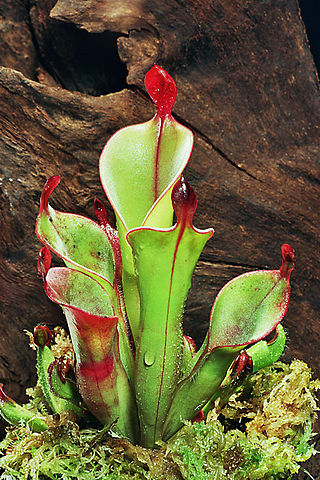
Sarraceniaceae are a family of pitcher plants, belonging to order Ericales.
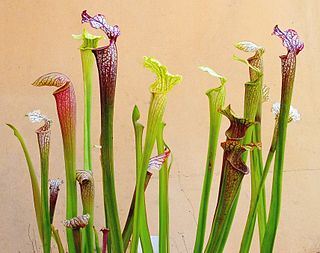
Sarracenia is a genus comprising 8 to 11 species of North American pitcher plants, commonly called trumpet pitchers. The genus belongs to the family Sarraceniaceae, which also contain the closely allied genera Darlingtonia and Heliamphora.

Flatwoods, pineywoods, pine savannas and longleaf pine-wiregrass ecosystem are terms that refer to an ecological community in the southeastern coastal plain of North America. Flatwoods are an ecosystem maintained by wildfire or prescribed fire and are dominated by longleaf pine, and slash pine in the tree canopy and saw palmetto, gallberry and other flammable evergreen shrubs in the understory, along with a high diversity of herb species. It was once one of the dominant ecosystem types of southeastern North America. Although grasses and pines are characteristic of this system, the precise composition changes from west to east, that is, from Texas to Florida. In Louisiana, savannas even differ between the east and west side of the Mississippi River. The key factor maintaining this habitat type is recurring fire. Without fire, the habitat is eventually invaded by other species of woody plants.
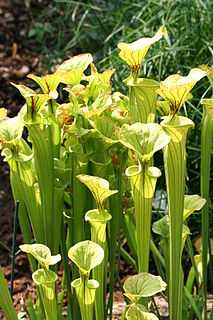
Sarracenia flava, the yellow pitcherplant, is a carnivorous plant in the family Sarraceniaceae. Like all the Sarraceniaceae, it is native to the New World. Its range extends from southern Alabama, through Florida and Georgia, to the coastal plains of southern Virginia, North Carolina and South Carolina. Populations also exist in the Piedmont and mountains of North Carolina.
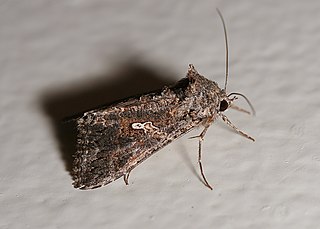
The cabbage looper is a medium-sized moth in the family Noctuidae, a family commonly referred to as owlet moths. Its common name comes from its preferred host plants and distinctive crawling behavior. Cruciferous vegetables, such as cabbage, bok choy, and broccoli, are its main host plant; hence, the reference to cabbage in its common name. The larva is called a looper because it arches its back into a loop when it crawls.

Sarracenia purpurea, the purple pitcher plant, northern pitcher plant, turtle socks, or side-saddle flower, is a carnivorous plant in the family Sarraceniaceae.
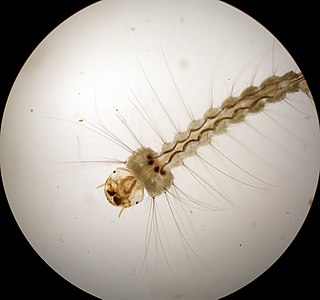
In zoology, an inquiline is an animal that lives commensally in the nest, burrow, or dwelling place of an animal of another species. For example, some organisms such as insects may live in the homes of gophers or the garages of human beings and feed on debris, fungi, roots, etc. The most widely distributed types of inquiline are those found in association with the nests of social insects, especially ants and termites – a single colony may support dozens of different inquiline species. The distinctions between parasites, social parasites, and inquilines are subtle, and many species may fulfill the criteria for more than one of these, as inquilines do exhibit many of the same characteristics as parasites. However, parasites are specifically not inquilines, because by definition they have a deleterious effect on the host species, while inquilines have not been confirmed to do so.

Acronicta rumicis, the knot grass moth, is a species of moth which is part of the genus Acronicta and family Noctuidae. It was first described by Carl Linnaeus in his 1758 10th edition of Systema Naturae. It is found in the Palearctic region. A. rumicis lives and feeds on plants located in wide-open areas. At its larval stage, as a caterpillar, it causes such a large impact as a crop pest that it has received much attention and research. A. rumicis feeds on maize, strawberries and other herbaceous plants.

Carnivorous plants are plants that derive some or most of their nutrients from trapping and consuming animals or protozoans, typically insects and other arthropods. Carnivorous plants still generate some of their energy from photosynthesis. Carnivorous plants have adapted to grow in places where the soil is thin or poor in nutrients, especially nitrogen, such as acidic bogs. They can be found on all continents except Antarctica, as well as many Pacific islands. In 1875 Charles Darwin published Insectivorous Plants, the first treatise to recognize the significance of carnivory in plants, describing years of painstaking research.
Meadowview Biological Research Station is a non-profit 501(c)(3) organization dedicated to preserving and restoring rare wetland plants, habitats and associated ecosystems on the coastal plain of Maryland and Virginia. It was created in 1995 with the specific goal or restoring the rare yellow pitcher plant, the purple pitcher plant, and associate species to pitcher plant bogs or seepage wetlands in their historic ranges.

Alypia is a genus of moths in the family Noctuidae.
Exyra fax, the pitcher plant moth, is a moth of the family Noctuidae. It is mainly found on the Atlantic Coastal Plain and Great Lakes region of eastern North America (from Manitoba through Michigan to Nova Scotia and Maine south to Georgia. The species is listed as threatened in Connecticut.

The pitcher plant mining moth is a moth of the family Noctuidae. It is found from Northern North Carolina south to Florida west to Texas and New Jersey.

Alypia ridingsii, the mountain forester or Ridings' forester, is a moth of the family Noctuidae. The species was first described by Augustus Radcliffe Grote in 1864. It is found in North America as far east as the eastern edge of the Rocky Mountains in Colorado. It is also found in Arizona, Utah, all of California and northward into Oregon, Idaho, Washington, British Columbia and Alaska
Ponometia semiflava, the half-yellow or yellow-cloaked midget, is a moth of the family Noctuidae. The species was first described by Achille Guenée in 1852. It is found in North America from New York and New England to Florida, west to Arizona, north to British Columbia and Manitoba.
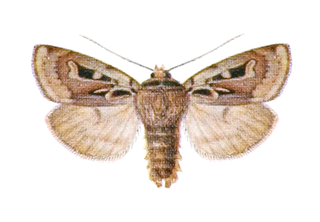
Xestia wockei is a moth of the family Noctuidae. It is known from Siberia and northern North America, including Quebec, Newfoundland and Labrador, the Northwest Territories and Yukon.

Alypia mariposa, the mariposa forester, is a moth of the family Noctuidae. The species was first described by Augustus Radcliffe Grote and Coleman Townsend Robinson in 1868. It is found in Coast Ranges and Sierra foothills of California, from Kern and San Luis Obispo counties in the south to Placer County in the north.

Neominois ridingsii, or Ridings' satyr, is a species of butterfly in the family Nymphalidae. It is found from southern Alberta, Saskatchewan and Manitoba south to the Guadalupe and Catron counties of New Mexico, and west to the central Sierra Nevada of California and central Oregon. The habitat consists of short-grass prairie, intermountain areas and grasslands with some areas of bare soil.

Sarracenin is an iridoid found in several plant species in the carnivorous family Sarraceniaceae. It also occurs in other non-carnivorous plants such as Strychnos spinosa (Loganiaceae) and Patrinia heterophylla (Caprifoliaceae).
References
- ↑ Ricci, C. A., Meier, A. J., Meier, O. W., & Philips, T. K. (2016). The effects of fire and other habitat characteristics on habitat selection of Exyra ridingsii (Riley), the Riding's Pitcherplant Looper Moth. castanea, 81(2), 83-90.
- ↑ Ricci, C. A., Meier, A. J., Meier, O. W., & Philips, T. K. (2017). Effects of Exyra ridingsii (Lepidoptera: Noctuidae) on Sarracenia flava (Nepenthales: Sarraceniaceae). Environmental entomology, 46(6), 1346-1350.